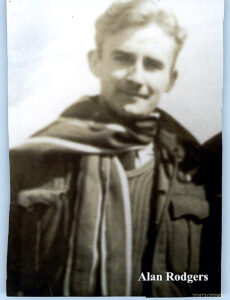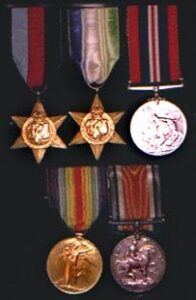Sergeant ALAN RODGERS
St Bees Dead of World War II
Roll of Honour
Sergeant ALAN RODGERS
650668, Royal Air Force, who died aged 21 on 7th April 1943.
Son of George and Mabel Rodgers, of 3, Seaview, St. Bees
Remembered with Honour
Charles de Percy War Cemetery

Alan Rodgers was born at Seaview on March 6th 1922, the first of the seven children of George and Mabel Rodgers. He went to the village school (then known as the Council School) during Abraham McClellan’s headship. At the age of ten he joined the church choir, at eleven the 1st St. Bees Scouts, and on his fourteenth birthday he was confirmed in the Priory.
After leaving the Village School, Alan, perhaps aided by a fine testimonial from Mr. McClellan, he became an apprentice at Messrs. Waite and Saville, makers of diestamp presses for the printing industry.
Soon after his seventeenth birthday, and just seven weeks before the outbreak of war, he enlisted as 650668 Aircraftman 2nd Class Rodgers A. Promotion steadily followed: to Aircraftman 1st Class in August 1940, then Leading Aircraftman, then Corporal. He reached Sergeant’s rank in July 1942. By early 1940 he was in France with 245 Hurricane Squadron, his letters from Abbeville telling of severe German bombing and of his work in returning damaged planes to service.
Further training followed his return to the UK, some of it at an Air Gunners’ school, but by April 1942 he was in Canada as a Flight Engineer with RAF Ferry Command. Ferry Command – soon to be RAF Transport Command – had the task of flying to the UK newly-built aircraft from Canada and America. Alan Rodgers, as Flight Engineer, made four such flights in quick succession, ferrying Catalina flying boats from North Carolina to Scotland by way of Bermuda. The distance involved approaches the Catalina’s maximum range, so to save weight these planes customarily flew unarmed.The fifth flight was in Catalina FP138.
The six-man crew was made up of one American and three Canadians (who technically were civilians), and from the RAF, a navigator and Alan Rodgers as Flight Engineer. After Bermuda, the destination was Largs in Scotland. Some 23 hours after take-off, they had a radio instruction to divert to Plymouth, because adverse weather had made a Largs landing unwise. Exactly what happened then is uncertain, but perhaps due to a navigational error they were, three hours later, near the coast of Normandy and running low on fuel.To avoid landing on the open sea the Captain decided to head for a coastal inlet. As they approached and lost height, German anti-aircraft guns opened fire on them from both sides of the inlet. The aircraft turned and regained height to escape, but was then attacked by two Luftwaffe fighters. With the Navigator killed in his seat and the First Officer wounded in the back and legs, the Captain brought the now damaged Catalina down close to some rocks two miles offshore.Still under fire, the survivors left the aircraft and attempted to swim to the rocks. Three were subsequently rescued by French fishermen and spent the rest of the war as prisoners.
The bodies of the other three were washed up on Normandy beaches – two on the second day, but Alan Rodgers’ not until twenty days later, near Kerlouan.The Germans buried the body, with military honours, in the cemetery at Kerlouan. Soon after the war the coffin was opened briefly to check identification, and then lay undisturbed until 1980, when the cemetery was cleared. Alan Rodgers now rests in the St. Charles de Percy War Cemetery in Normandy. The words chosen by his family and inscribed on his headstone are:
“Where our treasure lies, there will our hearts be also”
Michael’s father Keith Rodgers, one of Alan Rodgers’ brothers, assembled a truly remarkable collection of documents, photographs, official letters and personal ones, relating to his life and death. Alan Rodgers’ Service Record, and a more detailed account of his last flight, is given in Appendix A.
Historical note on Ferry Command
Up to 1939, there had been fewer than one hundred successful air crossings of the Atlantic. The great distances, the miserable winter weather and the lack of airfields led many to believe that regular flights across the Atlantic were impractical. Nonetheless, the pressures of war forced a reconsideration, and RAF Ferry Command was formed to fly American-built aircraft to Britain – mostly from airfields at Gander, Newfoundland and Goose Bay, Labrador. Between 1940 and 1945 over 11,000 aircraft were delivered across the Atlantic. About 150, carrying 560 personnel, were lost in ferry operations.
Sources: ‘Ocean Bridge: The History of RAF Ferry Command’, Carl A Christie, Toronto University Press, 1995; ‘A Brief History of the Royal Air Force’ AP3003, 2004.
From ‘The Whitehaven News’ 22 April 1943 page 5, under ‘St. Bees’
St. Bees Sergeant Missing
Mr. and Mrs. G. Rodgers, ‘Seaview’, St. Bees, have been officially informed that their eldest son, Flt. Engineer Alan Rogers, is missing from operations with the Ferry Command. He has made a number of flights across the Atlantic. Sgt. Rogers was expected home soon for a belated celebration of his 21st Birthday, which fell on March 6th.
The Under-Secretary of State for Air presents his compliments, and by command of the Air Council has the honour to transmit the enclosed Awards granted for service. The Council share your sorrow that Sergeant A. Rodgers, in respect of whose service these awards are granted, did not live to receive them.
APPENDIX A
Additional information on ALAN RODGERS
The archive held by Mr. Michael Rodgers contains a detailed account of his uncle’s RAF service, together with a considerable number of photographs and documents. These include his Church Choir Membership and Confirmation Certificates, his Boy Scout Enrolment Cards, his last telegram home and some personal letters. These are not shown here, but they are included in the written record held by the Priory Church, the Village Library, and the Record Office in Whitehaven. Alan Rodgers’ Service Record reads:
Sergeant (Flight Engineer) 650688 Alan Rodgers RAF
Enlisted 12/07/39
2 Depot Cardington 12/09/39
3 Wing Hednesford 06/12/39
245 Squadron 10/05/40
Fighter Sector Headquarters 26/03/41
Aldergrove Station Bally Herbert 28/06/41
245 Squadron 25/07/41
Station Halton 19/09/41
6 School of Technical Training 15/11/41
10 Air Gunners’ School 21/02/42
1651 Conversion Flight 04/04/42
RAF Moncton (Canada) 11/04/42
Ferry Command HQ Dorval 26/05/42
(Canada) Missing 07/04/43
Killed in Action 07/04/43
_______________________
Ranks
Aircraftman 2nd. Class 12/07/39 Aircraftman 1st. Class 01/08/40 Leading Aircraftman 01/02/41 Corporal 01/06/41 Sergeant 17/07/42
_______________________
ALAN RODGERS’ FINAL FLIGHT
Research by Keith Rodgers has left us a detailed account of the journey which ended with his brother’s death.In the weeks leading up to it, Alan Rodgers had made four crossings of the Atlantic, returning as Flight Engineer in newly-built Catalina flying boats. It was usual for the outward journey to be made via Iceland and Newfoundland in a Liberator of the North Atlantic Return Ferry Service – sometimes, it is said, with passengers lying on mattresses in the bomb bays. Whether this was so in Alan’s case we do not know.On March 2nd 1943 he reported to Ferry Command’s HQ at Dorval, Montreal. With him were two companions: Flying Officer Keith Thompson of the RAF, who would be the return flight’s navigator, and RLG Browne, a Radio Operator. Roslyn Lloyd George Browne was a 24 year old civilian from Ottawa, Ontario, working with RAF Ferry Command.
From Montreal they travelled by rail and coach to New York and Chesapeake Bay, and then on to Elizabeth City in North Carolina (which did not impress Alan as a ‘city’). There, on the 10th March, they met the rest of the crew. A photograph exists of the whole crew outside their hotel. It was four days after Alan’s 21st birthday.Their instructions were to take charge of Catalina FP138, and to deliver it, via Bermuda, to Largs in Scotland. This Catalina had been built by the Consolidated Aircraft Company of San Diego, and was moored awaiting collection in Albemarle Sound.The crew, made up Canadians, an American, and a Briton, was: Eddie Stafford Captain Pilot (civilian attached to RAF Ferry Command) Harry Leo Abrin First Officer (civilian attached to RAF Ferry Command) Keith Thompson Navigator (RAF) RLG Browne Radio Officer (civilian attached to RAF Ferry Command) HL Covert Radio Operator ( Sergeant, USA Transport Command) Alan Rodgers Flight Engineer (RAF Ferry Command)On 23rd March (we do not know the cause of the delay, but it was not unusual) they flew to Darrells’ Island in Bermuda. This 700 mile hop gave an opportunity to check out the Catalina.
Again after a delay, they took off for Largs at 1100 hrs. GMT on Tuesday 6th April, and as was usual for such a long flight, weight was reduced by flying unarmed.At 0940 on the following morning, Radio Operator George Browne made contact with Prestwick. He was advised that because of a North Westerly gale and poor conditions in the Clyde Estuary, they should divert to RAF Mountbatten, Plymouth.There is some doubt about what happened next. There may have been a navigational error; they were certainly flying in bad conditions. Whatever the cause, by 1240 GMT they were much further South than intended and running low on fuel. Because of the need to make a landing the pilot headed for a coastal inlet, where he expected better conditions than on the open sea.
This inlet proved to be Aber Wrac’h, between Plougeurmeau and Landeda, Finisterre. As the Catalina descended to 500 feet, German anti-aircraft batteries opened fire from both sides of the inlet. The aircraft was hit several times. Captain Stafford regained height and headed away from the inlet, but as they flew along the coast they were again attacked, this time by two fighter planes from unit 8/JG2 of the Luftwaffe. First Officer Abrin was killed in his seat. Navigator Keith Thompson was hit in the back and legs. Stafford brought the plane down successfully, close to a small outcrop of rock some two miles offshore near Vougot. Although still under fire, those able to exit the plane attempted to swim to the outcrop. Three – Stafford, Covert and the wounded Thompson – were rescued from there by the Abernot brothers, French fishermen acting under German direction; Abrin, Browne and Alan Rodgers were missing. Feldwebel (Sergeant) Walter Ebert of the Luftwaffe claimed to have shot down the Catalina at 1345 hrs. local time.Two days later the bodies of George Browne and Leo Abrin were washed ashore at Vougert beach. Browne was buried in the cemetery at Plouguemeau; Abrin in Bayeux.
Alan Rodgers’ body came ashore near Kerlouan nearly three weeks later, and was given a military funeral at 1500 hrs on 27th April in Kerlouan cemetery. It was exhumed briefly after the war to check the identity, then re-buried there; in 1980 on the closure of the cemetery it was taken to its present resting place, the St. Charles de Percy War Cemetery near Caen in Normandy.
The three survivors passed the rest of the war in captivity. When he had recovered from his wounds Keith Thompson was sent to Stalag Luft III, where he was involved in the tunnel digging for the “Great Escape”. He was number 103 on the escape list, and the Germans discovered the tunnel before his turn came. Perhaps this was fortunate, for if he had escaped he might have been amongst the fifty escapers subsequently murdered by the Gestapo.
Until 1963 Catalina FP138 remained in reasonably sound condition in 70 feet of water. It then broke up in a severe storm, but for long afterwards some parts could still be seen at low tide.
Keith Rodgers’ Sources:
Eyewitness accounts of the end of the flight from Monsieur Abernot and his brother. Travel details Dorval to Elizabeth City from RGL Browne’s sister in Canada.Accounts of Elizabeth City are in letters to his family from Alan Rodgers and his girlfriend. Keith Thompson’s account of what happened was given to his close friend Herbert Mellor, who should originally have been on the flight instead of Keith Thompson.
Reference to Luftwaffe Pilot Feldwebel W Ebert from Dutch researcher Henk Welting.
Air Ministry letter to Alan Rodgers’ mother – 1946
AIR MINISTRY (Casualty Branch)
77 Oxford Street,
London W1
22nd July 1946
Dear Mrs. Rodgers,
I have to refer to previous correspondence from this Department and to inform you that the Royal Air Force Missing Search and Enquiry Service have now located the burial place of your son, Sergeant A. Rodgers. The Catalina in which he was flying was attacked by two German fighters, fired at by anti-aircraft batteries from the shore, and fell into the sea off Plougueneau, Department of Finistere, France.
The bodies of two members of the crew were recovered from the sea by a fisherman, and they were later buried by the Germans at Plouguerneau Cemetery. Your son’s was washed ashore at a point on the coast called Neisvran, in the Commune of Kerlouan, 5 miles north of Lesneven, also in Finistere. Your son was buried by the Germans at 1500 hours on 27th. April, 1943, with military honours in the cemetery at Kerlouan.
Our investigating officer visited the grave and found it well cared for, planted with flowers and an evergreen border and surmounted by a cross bearing the inscription “Ferry Command – Sgt. A. Rodgers”. The grave has no number, but is on the left hand side of the cemetery on entering. It will now be properly inscribed and registered by the Graves Registration Authorities.
We sincerely hope that the knowledge that your son was reverently laid to rest in friendly territory may afford you some measure of comfort in your irreparable loss.
Yours sincerely
C.W. Wright

